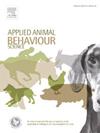Shelter use in horses: Time spent indoors and factors of variation – Results from a one-year longitudinal study
IF 2
2区 农林科学
Q1 AGRICULTURE, DAIRY & ANIMAL SCIENCE
引用次数: 0
Abstract
Stabling is a common lifestyle for horses, yet numerous studies show that it negatively impacts their welfare, leading to behavioural and health issues. In this study, we aimed to determine how much time horses choose to spend inside their stalls when given the option to be inside (in shelters/stalls) or outside at pasture. Using permanently installed night-vision cameras inside the stalls, we recorded 53 horses across 20 sites in temperate climates (France, Belgium) over a full year. We analyzed their stall presence and activity (lying down, observe, stand at rest, eat, etc.) for 72 consecutive hours each month over 12 months. The results show that, on average, horses spend only 3 h per day inside, and not consecutively (entering 2.5 times per day). There is a strong seasonal effect: horses spend twice as much time in their stalls in summer than in winter. This finding is notable as it contrasts with the usual advice of stabling horses in winter and turning them out to pasture in summer. In winter, horses predominantly return to their stalls late at night (00:00–06:00) to eat and lie down, while in summer, they return in the afternoon (12:00–18:00) to rest standing. Contrary to expectations, presumably rustic breeds (ponies) spent more time inside, and age had no effect on this, indicating that stalls are essential for all types of horses. Additionally, the larger the shelter (in sq m per horse), the more it is used. Stalls fully enclosed with a single access door are also associated with higher usage in summer, winter, and autumn, compared to an open shelter. The use of blankets in winter or fly masks in summer is not associated with a reduction of the time spent in the stalls, suggesting that these accessories do not substitute for shelter. There is also significant inter-individual variability among horses: the ideal is to allow them the freedom to come and go as they please in order to best respect their agency and individual needs.
马的住所使用:在室内度过的时间和变化因素-来自一年纵向研究的结果
马厩是马的一种常见生活方式,然而许多研究表明,这对它们的福利产生了负面影响,导致行为和健康问题。在这项研究中,我们的目的是确定马在被给予选择时选择在马厩内(在避难所/马厩)或在外面的牧场上花费多少时间。通过在马厩内永久安装的夜视摄像机,我们在一整年的时间里记录了温带气候(法国、比利时)20个地点的53匹马。在12个月的时间里,我们每个月连续72小时分析它们的隔间存在和活动(躺下、观察、站立休息、进食等)。结果表明,马平均每天只在室内呆3 h,并且不是连续的(每天进入2.5次)。有很强的季节性影响:马在夏天呆在马厩里的时间是冬天的两倍。这一发现值得注意,因为它与通常的建议形成了对比,即冬天把马关在马厩里,夏天把它们赶出去吃草。在冬季,马主要在深夜(00:00-06:00)回到马厩吃饭和躺下,而在夏季,它们在下午(12:00-18:00)回到马厩站着休息。与预期相反,可能是乡村品种(小马)花在室内的时间更多,年龄对此没有影响,这表明马厩对所有类型的马都是必不可少的。此外,庇护所越大(每匹马的面积),使用的就越多。与开放式庇护所相比,完全封闭的单门隔间在夏季、冬季和秋季的使用率也更高。冬季使用毯子或夏季使用防蝇口罩与减少在畜栏中度过的时间无关,这表明这些配件不能代替庇护所。马之间也存在显著的个体差异:理想的情况是允许它们自由来去,以最好地尊重它们的代理和个体需求。
本文章由计算机程序翻译,如有差异,请以英文原文为准。
求助全文
约1分钟内获得全文
求助全文
来源期刊

Applied Animal Behaviour Science
农林科学-行为科学
CiteScore
4.40
自引率
21.70%
发文量
191
审稿时长
18.1 weeks
期刊介绍:
This journal publishes relevant information on the behaviour of domesticated and utilized animals.
Topics covered include:
-Behaviour of farm, zoo and laboratory animals in relation to animal management and welfare
-Behaviour of companion animals in relation to behavioural problems, for example, in relation to the training of dogs for different purposes, in relation to behavioural problems
-Studies of the behaviour of wild animals when these studies are relevant from an applied perspective, for example in relation to wildlife management, pest management or nature conservation
-Methodological studies within relevant fields
The principal subjects are farm, companion and laboratory animals, including, of course, poultry. The journal also deals with the following animal subjects:
-Those involved in any farming system, e.g. deer, rabbits and fur-bearing animals
-Those in ANY form of confinement, e.g. zoos, safari parks and other forms of display
-Feral animals, and any animal species which impinge on farming operations, e.g. as causes of loss or damage
-Species used for hunting, recreation etc. may also be considered as acceptable subjects in some instances
-Laboratory animals, if the material relates to their behavioural requirements
 求助内容:
求助内容: 应助结果提醒方式:
应助结果提醒方式:


